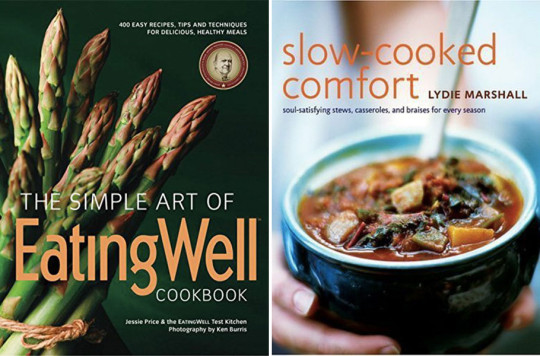I’m not a nutritionist or fitness guru, but I’ve set my fair share of New Year resolutions about getting healthier to know that achieving that goal goes beyond just trying the newest diet or joining the gym on January 1st. Or making a sweeping declaration. Your best bet for embarking on such an endeavor might be establishing reachable goals that don’t drastically alter your current lifestyle and making sure to give yourself some grace if you “fall off the wagon.” Luckily for all of us mere mortals, there are plenty of people out there that know this and present guides to implement a healthier lifestyle without taxing us with the responsibility of undergoing wholesale changes.
I am not going to take credit for the idea of “eating well.” It’s a concept recently introduced to me by Jason Moss. The idea is similar to what I introduced in the above paragraph – finding a balanced approach to better eating. “Healthy” is very dependent on your goals, body type and activity level. According to the CDC, there are some fundamental principles that one should follow:
- Emphasize fruits, vegetables, whole grains and fat-free or low-fat milk and milk products
- Include lean meats, poultry, fish, beans, eggs and nuts
- Reduce saturated fats, trans fats, cholesterol, salt (sodium) and added sugars
- Stay within your daily calorie needs
Along with these guidelines, you will also find that the CDC encourages moderation on your favorite comfort foods versus cutting them out altogether as well as avoiding most processed foods. Thank God because I’m not sure I would really give up mac and cheese but can certainly settle for 3 fork-fulls instead of the plate’s worth I might normally consume.
Eating Well also happens to be the name of a well-circulated magazine dedicated to exploring “Where Good Taste Meets Good Health.” In The Simple Art of Eating Well, the magazine’s editors cobble together recipes to make it easier to get your needed doses of Omega-3s, heart-healthy grains and daily allotment of plant-based nutrients. Along with additional ideas about how to eat better, you will find menu plans that you can follow to ensure you get everything you need from your meals.
I mentioned not jettisoning our favorite foods as part of a plan to be reasonable. You can also seek out a less caloric approach to creating those dishes as an alternative to reducing the amount you consume them. For instance, you can buy an air fryer to make fried chicken, or one could use this oven-frying recipe that adds a fraction of the unhealthy fat that deep-frying produces.
Picnic Oven-Fried Chicken
Serves 4
1/2 cup non-fat buttermilk
1 tablespoon Dijon mustard
2 cloves garlic, minced
1 teaspoon hot sauce
2 1/2-3 pounds whole chicken legs, skin removed, trimmed and cut into thighs and drumsticks
1/2 cup whole-wheat flour
2 tablespoons sesame seeds
1 1/2 teaspoons paprika
1 teaspoon dried thyme
1 teaspoon baking powder
1/8 teaspoon salt
Freshly ground pepper to taste
Olive oil cooking spray
Whisk buttermilk, mustard, garlic and hot sauce in a shallow glass dish until well blended. Add chicken and turn to coat. Cover and marinate in the refrigerator for at least 30 minutes or for up to 8 hours.
Preheat oven to 425 degrees. Line a baking sheet with foil. Set a wire rack on it and coat with cooking spray.
Combine flour, sesame seeds, paprika, thyme, baking powder, salt and pepper in a sealable bag. Tapping off excess marinade, place one or two pieces of chicken at a time in the bag and shake to coat. Tap off excess flour place the chicken on the prepared rack. Spray the chicken pieces with cooking spray.
Bake the chicken until golden brown and no longer pink in the center, 40-50 minutes.
I am a huge fan of braising or slow-cooking. It is a dummy-proof way of cooking that crosses cultural barriers. The goal behind this time-consuming (only because it takes hours to cook, not “busy” time) method is to breakdown connective tissue and present a fork-tender result. It can be used on meats (even cheaper, leaner cuts of beef) or vegetables, as Lydie Marshall does with this fennel recipe in Slow Cooking Comfort.
Braised Fennel
6 small fennel bulbs (3 pounds)
2 tablespoons olive oil
Salt
Freshly ground black pepper
Cut off the fennel stalks, reserving the green feathery leaves. Trim and halve the fennel bulbs.
In a 5 1/2-quart Dutch oven, heat 2 tablespoons olive oil. Brown the bulbs, cut side down first, until golden, then turn and continue browning over medium-low heat for about 20 minutes.
Season with salt and pepper.
Add 1 cup cold water and cover with buttered parchment paper. Put the lid on the pot and simmer slowly for 1 hour.
Uncover, discard the parchment paper and sprinkle with 2 tablespoons of the minced green feathery leaves. Turn up the heat and gently boil down the liquid until syrupy, basting the fennel bulbs with the light syrup.
Best of luck to you in your endeavors to improve your health. Be sure to stop COOK to pick up your copy of either book as well as many others that promote wholistic food consumption.
Back to Blog




